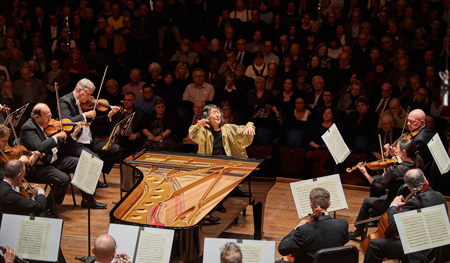by Daniel Hathaway

The increase in numbers came with stylistic consequences. The earlier concerto sounded lithe and transparent, the later one weighty and important, even a bit outsized. Beyond the sheer numbers of players involved, Concerto No. 12 expressed itself in the bright, cheerful key of A Major, while No. 20 was imbued with all the inherent solemnity of the key of d minor — the tonality Mozart chose for Don Giovanni, the Queen of the Night aria, and the Requiem, and that Beethoven later turned to for the Ninth Symphony.
While Uchida’s concept for No. 12 on Thursday evening pointed up Mozart’s wit, charm, and refinement, her approach to No. 20 was more Beethovenian: stormy, restless, and romantic. Even the pianist’s cadenzas in the later work were by Beethoven. Uchida played with an elegant presence and technical accuracy in both works. Everything was neatly in place, if not leavened by the occasional mischief that brings smiles and reminds us that the divine Mozart had an earthy sense of humor.
As usual for her annual appearance with the Orchestra, Uchida conducted from the keyboard, facing upstage, standing for orchestral expositions and interludes and sitting for solo passages, when she occasionally had a free hand to gesture to her colleagues. While The Cleveland Orchestra needs little in the way of guidance to play a Mozart concerto, the audience seems to be taken by the sight of a soloist multi-tasking, even when it occasionally leads to some imprecise ensemble playing — as in the Romance of No. 20.

Despite Mendelssohn’s complicated textures and the size of the string section, coordination was superb. The Cleveland Orchestra has been called a huge version of a chamber music ensemble, and in fact, that’s no hyperbole.
Photos by Roger Mastroianni, courtesy of The Cleveland Orchestra.
Published on ClevelandClassical.com April 10, 2017.
Click here for a printable copy of this article



